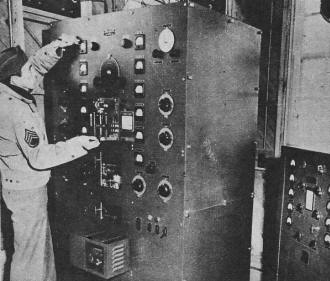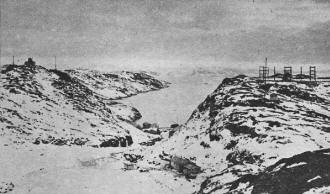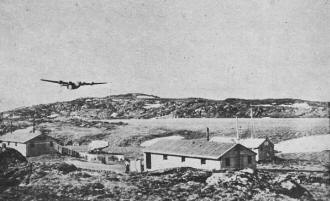|
The old adage about
pioneers taking the arrows is true in many realms - not just the exploration and
settling of the wild west. This story entitled "Sparks on Ice" recounting the
trials and tribulations of the troops who installed and debugged the first
arctic directional beacons appeared in a 1945 issue of Flying Age
magazine. "Sparks" (or "Sparky") was an endearing nickname given to early radio
operators who used spark gap transmitters to send out their Morse code messages.
It stuck around for many years after better transmitter systems were developed -
although it is not very often heard today. The most interesting part of Mark
Weaver's article is a discussion of the many atmospheric phenomena that affect
radio waves of various wavelengths. A lot of smart people - enlisted,
commissioned, and civilian - sacrificed mightily to work out the problems
experienced with aircraft directional beacon systems that guided traffic across
the north Atlantic and Pacific oceans.
Sparks on Ice - Radio in the Arctic

Radio range transmitter station along the much traveled North
Atlantic air route to England and all points east.
By Mark W. Weaver
Wandering radio waves, fading signals and the Aurora Borealis plagued the air-ground
radio operators on top of the world.
Not long ago an air-ground operator in Greenland was listening to a pilot on
a tactical flight give his position to a nearby station. It was the usual plane-to-ground
communication until an unmistakable feminine voice in a sugary drawl cut in.
"Will you rep't yoah position please ?" The operator at the ice-bound outpost
of the Army Airways Communications System muttered a weary curse. Skip-phase, one
of the banes in arctic radio, had brought a WAC in the control tower of a small
Georgia airfield onto the Greenland airwaves.
Skip-phase, the quaint habit possessed by certain radio waves of wandering all
over the face of the earth, coupled with "fading" signals, caused by the magnetic
antics of the Northern Lights, gives many an arctic radio mechanic mental hangovers.
Add to this temperatures so low that even brass monkeys go into hiding and you get
a sum that makes arctic aviation communication something not to write home about.
One sub-zero night in Presque Isle, a corporal working in a direction finder
tower called the "pickle-barrel," heard strange popping noises outside the shack.
One trek around the "barrel" disclosed nothing, but the noise persisted. Once again,
armed with a pistol, he moved out into the cold and checked. Red-faced, he returned
to his job muttering something about the "damn cold." The noises were made by the
cold forcing the nails out of the wooden tower.

On the beam, literally, is this ice-bound radio man keeping the
beam on which pilots depend in constant operation.
Since the pre-Pearl Harbor days of 41, when large-scale aviation radio first
penetrated into the land of ice, Eskimos, and blubber meat, much has been learned
about electronics in the Arctic. Nevertheless, skip-phase, fading, and other disturbances
still rank among the partially unsolved problems.
Before the war there had been only a few weather communications stations in the
far north. Fur trading outposts had radio for weather reports and contact with more
civilized spots. The Hudson Bay Company was one of the first to recognize the value
of radio in the land of Sam McGee. Four years ago a few navigational aids were put
up by the commercial airlines and, later, the Air Transport Command spotted the
more traveled routes. The Army Air Forces, more accurately the AACS, had one or
two isolated outposts.
A network of air-to-ground, point-to-point, radio range and homing beacon stations
was to be installed by the AAF and Signal Corps engineers, with civilian experts
advising. AACS was to help lay the groundwork, then stay on to operate the facility
while the engineers mushed on to the next job. There-were two terrific hitches to
this plan. Much of the equipment needed was still on factory assembly lines and
then there was the difficulty of getting the stuff moved into the arctic sites on
time.
Air transport was slated to handle some of the supply. This meant scraping runways
out of the glacier and swampland that makes up much of the country. A nice, clean
job sweated out the day before could become, with the unpredictable thaw, as rough
as a roller coaster by the time the first plane came in. As one AACS man put it,
"You can always trust muskeg and swampland to rise to the occasion - in the wrong
spots." Pilots got so used to rough runways that a smooth field would bother them.
A great deal of equipment was picked up by "foraging" parts from the Canadians.
This desperate hunt for radio parts became the basis for some tall tales of "midnight
requisitions." One of the best recalls a certain out-of-the-way station. A guard,
left on duty during the non-operating period, was seated in the warmth of a lean-to
tacked onto the radio shack. He relaxed too much and dropped into a sound sleep.
Some hours later, when awakened by the biting cold of the sub-zero weather, he found
nothing around him but the bleak arctic winterland. While he slept someone had moved
antenna poles, transmitter, and shack.
The setting for one arctic station is much like another ice-bound and frigidly
cold nine months out of twelve. Some sites are placed along the rocky coastlines;
others are far inland with a bed of soft muskeg as the foundation for transmission
lines and antenna poles. Moving heavy radio equipment over ground strewn with boulders
and full of unexpected soft spots is a well-nigh impossible task which had to be
done.
For an insight into the far north construction problem take the story told by
Major Harry A. Mackley, AACS officer. As officer in charge of installing a range
station in Labrador a little less than two years ago, Mackley and his crew moved
to the site in September.
"That's the time to get out of the arctic - not to move in. With the long, cold
winter night just around the corner, everything and everyone but AACS had sense
enough to hole up and hibernate," reminisced Mackley.
The chore of laying the tower foundations and sinking the antenna poles proved
to be a rough bit of work. Under a thin layer of moss were about eight to ten inches
of muskeg, and under that, in place of solid bedrock, foot after foot of boulder-impregnated
glacier ice.
Discussion inspired the idea of using concrete as artificial bedrock. The difficulty
lay in keeping the mixture of water, sand, gravel and cement in a semi-liquid state
long enough to get the poles set. A trial run was made. Heating the concrete "goulash",
almost to the boiling point kept it in a malleable condition long enough to get
the poles and tower supports down. It worked like a charm, but the ice melted unevenly.
The tower supports wound up looking like the work of a drunken artist. After further
trials of heating and setting the supports came out fairly even, but to this day
the tower has a slight cant.
Mackley summed up: "Fifteen to eighteen hours of work out of twenty-four was
not uncommon. The day wasn't done until the men were too tired to stand up. Living
conditions were rough. The cold of sub-zero winter was sneaking in on us and tents
are not exactly conducive to restful sleep. Food, though good, was scanty. We learned
to live on next to nothing - and like it!"

Direction finding stations like these dotting the Arctic have
saved many a lost plane by accurate position reports.
Sometimes the Eskimos can give a tip on construction problems. At Padloping Island,
above Baffin Bay. an Eskimo called Erkalling, assigned as guide and general handy
man to the AACS outpost, had to show the white men how to free their ice-locked
supply boat. Attempts at blasting had partially destroyed the old wooden tub. Erkalling,
with a grin on his moon-face, sprinkled ashes in a wide circle around the hull and
trailed a path to shore.
Two days later, with a minimum of ice-breaking, the AACS crew was able to move
the supply scow inshore. How did it work? After much head-scratching the C.O. decided
that the principle of heat absorption had done it. The ashes, being dark, had drawn
enough heat to melt the ice partially.
Not only in construction work, but in radio installation ingenuity has been required
desperately at many of the arctic stations. At a Greenland weather-communications
outpost, a crash boat served as an emergency transmitting and receiving station.
Snow slides and the forever ugly weather had made the hauling of supplies to
the picked site impracticable. Work could continue in three or four weeks, but the
weather information had to be radioed out at once.
All of the supplies, including the portable power unit, were on hand. Lines were
connected, receivers put in operation, and the antenna was tied to insulated poles
placed on the icecap. The only thing lacking was a proper ground for the transmitting
station. Ordinarily that would pose no problem. Marine radio simply tied in to the
steel hulls of the ships. But this was a wooden crash boat. Frantic searching brought
out a thin square of copper some three feet from edge to edge. Wires were connected
and the plate fastened to the wooden hull just under the water's surface. Communications
with the outside world hit the air on time.
This problem of grounding has proved one of the main hazards in arctic technical
operation. The relationship between ground and antenna is much like that of a huge
condenser - that is, an electrical field exists between the two. Consequently, improper
grounding weakens or dissipates signal strength.
At most stations the ground can be of the conventional radiating type. A radial
system of wires buried in moist earth keeps the energy loss low.
To reduce this energy loss caused by the dry, sandy or rocky terrain found at
a number of arctic sites, a system of grounding called "counterpoise" was used.
This consisted of a network of wires, erected a few feet above the ground, but insulated
from it and stretched in wheel-spoke fashion with the transmitter as its center.
Counterpoise has done much in certain cases to prevent energy loss.
The antics of the more coy frequencies, those that suffer from fading or remain
completely silent, cause AACS radio operators and pilots the most trouble. It is
a bit bothersome, while sitting about 10,000 feet up to receive a weather report
from the ground, and have a signal go bashful and drop completely off the dial.
The crux of this lies in the magnetic tricks played by the Aurora Borealis and the
Heaviside layer. The latter is supposed to shortstop the radio waves and send them
back to earth, but sometimes it misses a few. Waves higher than the Heaviside's
critical frequency just won't bounce back to earth. Heavy magnetic storms or sun
spot trouble change the Heaviside's critical frequency constantly.
A rapid shifting of frequencies has been projected by some radio engineers as
a partial cure for fading. Thus far, however. the only solution is to use mediums
that will be least affected. The low frequency of the radio range and homing beacon
suffered little during these electronic storms.
Several years ago Brigadier General, then Colonel, Ivan L. Farman, head of the
worldwide AACS, passed along the word to the arctic stations to get traffic through
if they had to use carrier pigeons. With that statement he paved the way for the
use of low frequency transmission. A flexible interpretation of the general's words
was made, bringing into sub-zero radio the extensive use of long-wave nets.
Forced to continue operation on the higher frequencies, air-to-ground and direction-finding
stations still suffer spasmodic attacks of fading and erratic behavior. The problem
of skip-phase causes some odd tricks on the dial. Frequency skips come so rapidly
that a foreign program will wander in during a local broadcast and a few seconds
later just as casually wander off.

No airstrip at this bleak and lonely arctic outpost and so a
B-24 Liberator must skim low to drop food, fuel and equipment.
Not all of the knots to be untied in sub-zero radio are of a technical nature.
At one Newfoundland station the transmitter site was being changed. Two AACS maintenance
sergeants were faced with the problem of continuous operation. By using a spare
transmitter and stringing temporary lines they remained in operation. Headquarters
wired requesting the time and how long the station would be off the air. The two
wired back grinningly that the move already had been made without a break "by the
grace of God and more wire than the telephone company had."
Or consider the case of this soldering iron expert at a North Canadian outpost.
His equipment was located in the back of a truck. Unable to get his transmitters
warmed up properly for operation, he wrapped GI socks around the rectifier tubes.
The added heat gave him enough soup to contact plane traffic in his area.
Navigational aids such as radio range and homing beacon stations have come a
long way in precision. When first placed in operation in the far north the pilots
used to complain about the range legs having more curves than chorus girls. Too,
it was embarrassing to ride blithely along just following the homing beacon and
find yourself dead-heading for some mountain.
Today, AACS planes, crammed to the tail surfaces with the latest in electronic
test gadgets ride the legs of ranges, from the Aleutians to Greenland as a check
for any new quirks in the way of splits, dog legs. and false builds. They follow
a homing beacon down its freezing route from Baffin Bay to Edmonton to watch for
error. In this manner of check and double check much of the difficulty in controlling
radio in the north has been simplified.
Even though much is still to be learned, in the words of one pilot, "the Arctic
may not be completely licked, but the AACS radio set-up has it well in hand."
Posted December 15, 2020
|